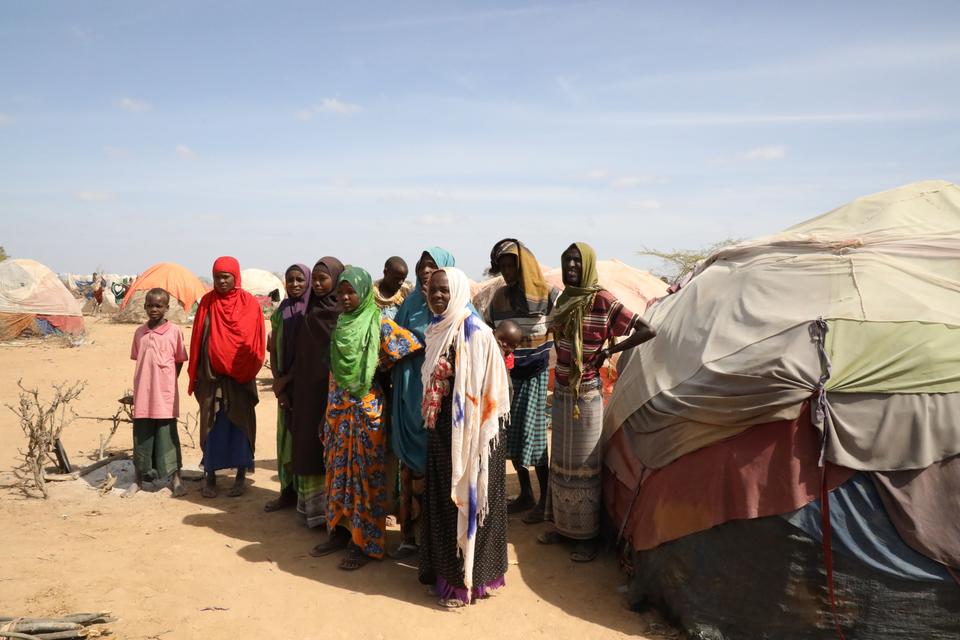“ Destroying crops, killing livestock, Eastern Africa’s worst drought season in decades has led to famine and the mass displacement of people across Somalia.
Somalia has been facing an unprecedented drought following three consecutive failed rainy seasons that has led to the displacement and death of scores of people.
The UN agency World Food Programme (WFP) estimates that 13 million people in Kenya, Somalia and Ethiopia are facing severe hunger due to extreme dry conditions.
Last month, the WFP called for $327 million in funds to help 4.5 million people become “more resilient to climate extremes” in Ethiopia, Kenya and Somalia.
The crisis has led international organisations scrambling to avoid a repeat of the 2011 drought in Somalia that led to the death of around 250,000 people from hunger.
In an effort to stop history repeating itself, international charity organisation Islamic Relief wants to be “as proactive as we can, as part of the NGOs community in Somalia,” the group’s country director for Somalia, Aliow Mohamed, told TRT World.
The organisation assists people across nearly 40 countries who have been affected by natural and manmade disasters. It doubled its Hunger Appeal to $26 million last month, to collect funds for the drought-stricken country and its neighbours.
“Somalia has not received enough rainfall for the last three years and the situation has just been getting worse,” Mohamed said, explaining that 90 percent of the country is currently facing severe drought conditions.

(Islamic Relief Worldwide)
This year, Mohamed’s team visited the Iftin camp for internally displaced people (IDP) in Somalia’s Bardhere district in the Gedo region, where authorities reported 118 people died within one week.
“Two weeks ago we visited a camp and our team [saw] a number of children dying, people with no basic health care and facilities such as food and water,” said Mohamed.
And yet as the drought continues, the number of families coming to the camp seeking aid grows each day. During their visit, Mohamed said there were 2,319 families at the camp but just over a week later this number reached 3,375 families.
Currently, Islamic Relief has enough aid to assist 400 families for four months in Somalia until the next rainfall, but as camp numbers grow, resources are being “stretched beyond expectation,” says Mohamed.
“The challenge our team are reporting [is] the moment people know there is food or some aid is being provided in a certain camp, they tell one another so everyone will now come to this camp,” said Mohamed, warning that this influx strains limited resources.

Below-average rainfall
As one of the biggest Muslim organisations worldwide, Islamic Relief has been providing aid across Somalia since 2016, according to Mohamed.
The organisation not only provides immediate relief to vulnerable communities but also helps them build economic empowerment in order to be more resilient to further challenges that come their way, explains Mohamed.
Mohamed has worked for Islamic Relief for almost 10 years and has been the country director for Somalia since 2019. Among many other titles, he has worked as a Disaster Risk Reduction Manager at the regional office in Nairobi.
He explained that Somalia has two rainfall seasons in a year: a long rainfall season from April to June and a shorter season from September to November.
Yet for the last three years, these two rainfalls have either been below average or non-existent.
Mohamed said the group is expecting rain in April, according to local forecasts. But it is unlikely the rainfall will be enough to create adequate forage for animals or water for the farmers.

Conflict coupled with climate change
Within East Africa, Somalia, Ethiopia, Kenya have similar weather patterns and have been affected by the drought, especially southern Ethiopia and northeastern parts of Kenya.
But Somalia is particularly vulnerable as it has been struggling to form a stable government for the last 30 years, leading to the rise of armed groups and conflict throughout the country.
So while the drought can be blamed “purely on climate change” according to Mohamed, “there are of course compounded factors such as conflict and instability within the country.”
“As much as the severity of the drought is the same, due to these armed groups and conflicts, close to 4 million people are internally displaced,” said Mohamed. “A number of them have run away to refugee camps in Kenya, some to Ethiopia.”
If Somalia’s upcoming rainy season does fail, the number of individuals facing food insecurity could shoot up to 7-8 million, warns Mohamed.

And yet if it does rain, the country’s continued instability will still continue to impact the vulnerable communities at the camps.
“It will only reduce the intensity of the situation but a majority of the people will still continue to be in these camps and the situation will continue,” said Mohamed.
“If we have a stable government and a secure environment which is free from armed groups, communities will engage in businesses and be able to feed themselves and feed their families,” he adds.
So far Islamic Relief has received $6 million in funds so far from their appeal, allowing them to provide water, food rations and cash to IDPs, according to Mohamed.
Last month, alongside all local and international NGOS in Somalia, the group sent an appeal letter to the UN agencies, embassies and international communities to come and provide urgent aid for the country.
“Hopefully the international communities, the embassies, will be able to listen to us and through their own means and mechanisms, will be able to fundraise and come to the aid of the Somali community,” said Mohamed.”
